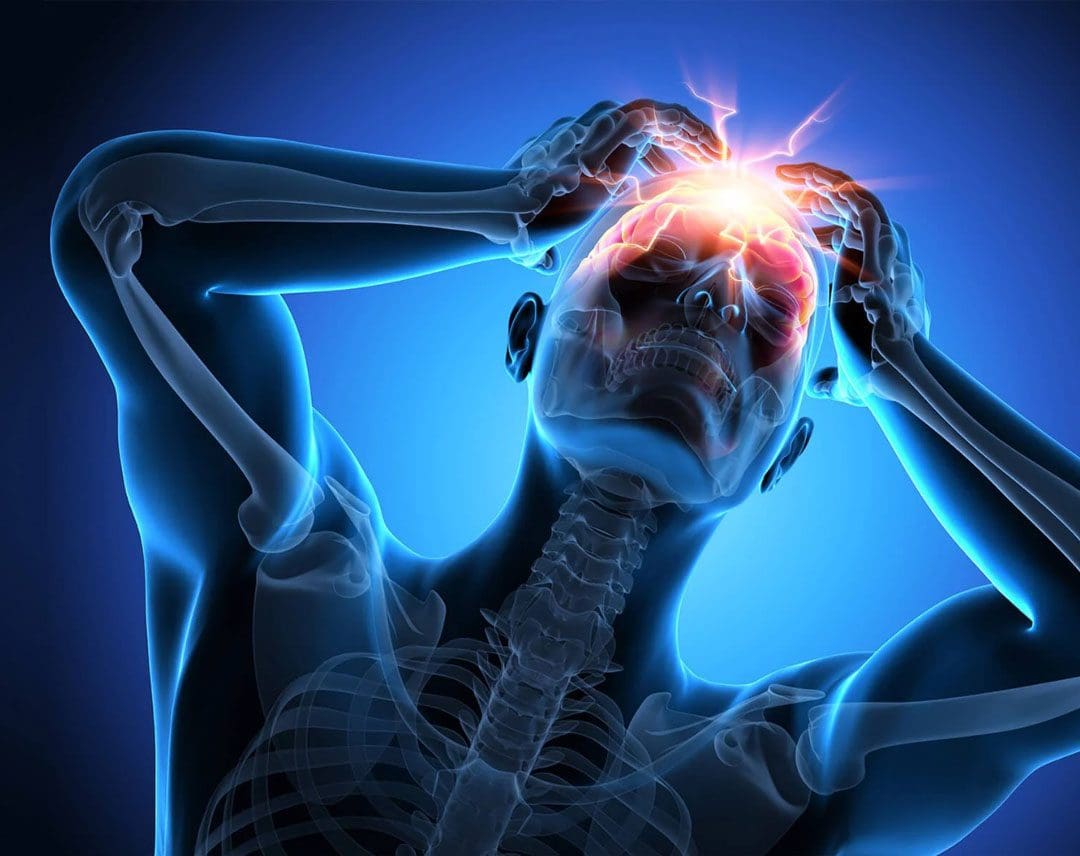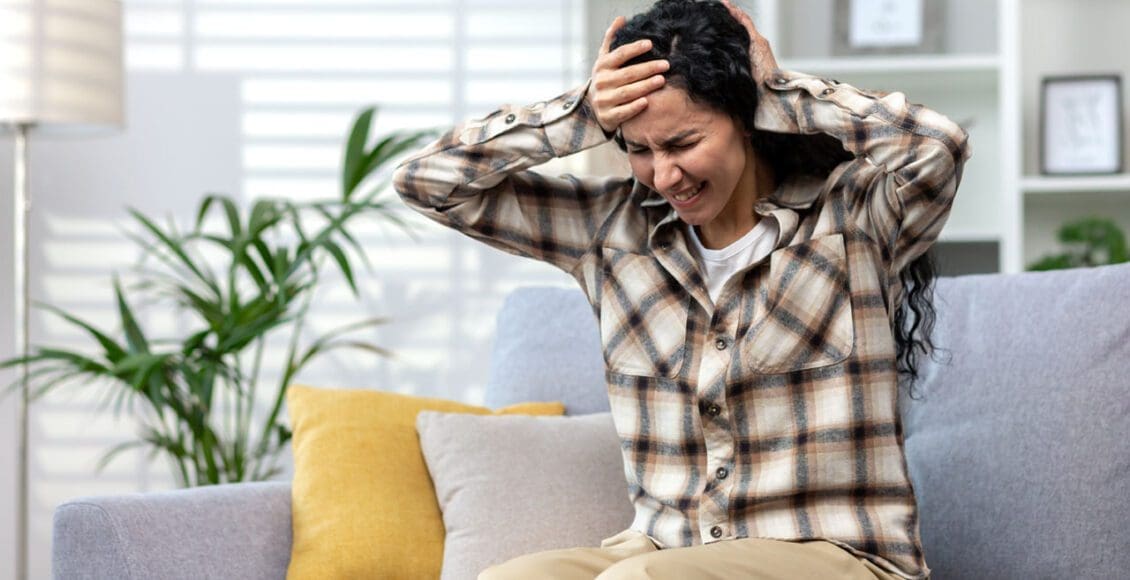Individuals experiencing headaches on top of the head could be caused by different factors. Can recognizing what triggers pain or pressure help prevent this type of headache, and healthcare providers develop effective treatment plans?

Table of Contents
Headache On Top of The Head
Various factors could cause a headache on top of the head; common causes include:
- Stress
- Sleep problems
- Eye strain
- Caffeine withdrawal
- Dental problems
- Hormonal changes
- Alcohol consumption
Causes
Many causes have to do with underlying issues happening in other parts of the body.
Stress
- Stress is a common cause of headaches, including one on top of the head.
- Researchers don’t know exactly how stress causes headaches, but they think it causes tightening of the muscles in the back of the head or neck, which
- pulls the tissues down, resulting in pain or pressure in the scalp and/or forehead area.
- These are also called tension headaches.
- Headaches caused by stress generally feel like dull pressure rather than throbbing pain.
Sleep Problems
- Not getting enough sleep can induce a headache on top of the head.
- When the mind and body do not get proper sleep, it can interfere with body functions like temperature, hunger, and sleep-wake cycles, which can lead to headaches.
- It is common to feel more stressed when sleep-deprived, which can cause or compound a headache and other symptoms.
Eye Strain
- You may develop a headache on the top of your head after you’ve been reading, watching, or otherwise focusing on something for a while.
- Over time, your eye muscles tire and have to work harder, causing them to contract.
- These spasms can lead to headaches. Squinting can make the muscle contractions even worse.
Caffeine Withdrawl
- Individuals may feel pain on the top of their heads if they skip their regular coffee.
- Regular caffeine consumption can lead to dependency and withdrawal symptoms, which include headaches when intake is reduced or stopped.
- This type of headache can be moderate to severe and can feel worse with activity.
- Most individuals start to feel better from caffeine withdrawal after a week. (World Health Organization. 2016)
Dental Problems
- Teeth issues like cracks, cavities, or impaction can irritate the trigeminal nerve, setting off head pain.
- Teeth grinding can also lead to headaches.
Hormonal Changes
- Individuals who have a low level of thyroid hormone may experience headaches.
- This could be from having too little thyroid or a symptom of the condition.
- Like stress-induced headaches, this type is generally dull and not throbbing.
- Some women may feel pain on the top of their heads before menstruation triggered by estrogen levels dropping.
Alcohol
- Some individuals develop a headache on the top of their head or elsewhere within a few hours after drinking alcohol.
- This is known as a cocktail headache.
- Alcohol-induced headaches usually resolve within 72 hours.
- The mechanism behind this headache is not fully researched, but it’s been thought that the widening of blood vessels in the brain/vasodilation when consuming alcohol may trigger head pain.
- This type of headache is different than a hangover headache that comes from overconsumption and is based on dehydration and the toxic effects of alcohol. (J G Wiese, M. G. Shlipak, W. S. Browner. 2000)
Rare Causes
Top-of-the-head pain can also result from more serious and rare causes:
Brain Tumor
- Headaches are one of the most common symptoms of brain tumors.
- A headache on the top of the head depends on the location and size of the tumor. (MedlinePlus. 2021)
Brain Aneurysm
- This is a weak or thin area in a brain artery that bulges and fills with blood, which can cause a life-threatening rupture.
- Headaches are the most common symptom. (Brigham and Women’s Hospital. 2023)
Brain Bleed
- Also known as a brain hemorrhage, this condition can cause intensely painful and quick headaches.
- Brain bleeds can be caused by head trauma, high blood pressure, an aneurysm, a bleeding disorder, or liver disease. (New York-Presbyterian. 2023)
Treatment
Treatment for reducing a headache on top of the head includes:
- Putting an ice bag over the area to reduce inflammation.
- Getting an eye examination.
- Making healthy lifestyle adjustments like drinking more water throughout the day.
- Less caffeine intake.
- Changing sleep patterns for a healthier, rested mind and body.
- Taking a therapeutic bath to relax the body.
- Gentle exercises like walking, pilates, or yoga.
- Practicing deep breathing.
- Mindfulness exercises like meditation.
- Taking non-steroidal anti-inflammatory medication or NSAIDs like aspirin, Advil/ibuprofen), or Aleve/naproxen.
Depending on the cause and symptoms, a doctor may suggest specialist treatment options like:
- Physical therapy
- Cognitive behavioral therapy
- Chiropractic therapy
- Acupuncture
- Prescription medication
A medical professional will be able to help identify the type of headache being experienced, offer treatment options, and advise on how to manage triggers.
Neck Injuries, El Paso, Texas
References
World Health Organization. (2016) Headache disorders.
Wiese, J. G., Shlipak, M. G., & Browner, W. S. (2000). The alcohol hangover. Annals of internal medicine, 132(11), 897–902. https://doi.org/10.7326/0003-4819-132-11-200006060-00008
MedlinePlus. (2021) Brain tumor.
Brigham and Women’s Hospital. (2023) Brain aneurysm.
New York-Presbyterian. (2023) Brain hemorrhage.
Post Disclaimer
Professional Scope of Practice *
The information herein on "Headache on Top of The Head: Dealing with Underlying Causes" is not intended to replace a one-on-one relationship with a qualified health care professional or licensed physician and is not medical advice. We encourage you to make healthcare decisions based on your research and partnership with a qualified healthcare professional.
Blog Information & Scope Discussions
Welcome to El Paso's Premier Wellness, Personal Injury Care Clinic & Wellness Blog, where Dr. Alex Jimenez, DC, FNP-C, a Multi-State board-certified Family Practice Nurse Practitioner (FNP-BC) and Chiropractor (DC), presents insights on how our multidisciplinary team is dedicated to holistic healing and personalized care. Our practice aligns with evidence-based treatment protocols inspired by integrative medicine principles, similar to those found on this site and our family practice-based chiromed.com site, focusing on restoring health naturally for patients of all ages.
Our areas of multidisciplinary practice include Wellness & Nutrition, Chronic Pain, Personal Injury, Auto Accident Care, Work Injuries, Back Injury, Low Back Pain, Neck Pain, Migraine Headaches, Sports Injuries, Severe Sciatica, Scoliosis, Complex Herniated Discs, Fibromyalgia, Chronic Pain, Complex Injuries, Stress Management, Functional Medicine Treatments, and in-scope care protocols.
Our information scope is multidisciplinary, focusing on musculoskeletal and physical medicine, wellness, contributing etiological viscerosomatic disturbances within clinical presentations, associated somato-visceral reflex clinical dynamics, subluxation complexes, sensitive health issues, and functional medicine articles, topics, and discussions.
We provide and present clinical collaboration with specialists from various disciplines. Each specialist is governed by their professional scope of practice and their jurisdiction of licensure. We use functional health & wellness protocols to treat and support care for musculoskeletal injuries or disorders.
Our videos, posts, topics, and insights address clinical matters and issues that are directly or indirectly related to our clinical scope of practice.
Our office has made a reasonable effort to provide supportive citations and has identified relevant research studies that support our posts. We provide copies of supporting research studies upon request to regulatory boards and the public.
We understand that we cover matters that require an additional explanation of how they may assist in a particular care plan or treatment protocol; therefore, to discuss the subject matter above further, please feel free to ask Dr. Alex Jimenez, DC, APRN, FNP-BC, or contact us at 915-850-0900.
We are here to help you and your family.
Blessings
Dr. Alex Jimenez DC, MSACP, APRN, FNP-BC*, CCST, IFMCP, CFMP, ATN
email: coach@elpasofunctionalmedicine.com
Multidisciplinary Licensing & Board Certifications:
Licensed as a Doctor of Chiropractic (DC) in Texas & New Mexico*
Texas DC License #: TX5807, Verified: TX5807
New Mexico DC License #: NM-DC2182, Verified: NM-DC2182
Multi-State Advanced Practice Registered Nurse (APRN*) in Texas & Multi-States
Multistate Compact APRN License by Endorsement (42 States)
Texas APRN License #: 1191402, Verified: 1191402 *
Florida APRN License #: 11043890, Verified: APRN11043890 *
License Verification Link: Nursys License Verifier
* Prescriptive Authority Authorized
ANCC FNP-BC: Board Certified Nurse Practitioner*
Compact Status: Multi-State License: Authorized to Practice in 40 States*
Graduate with Honors: ICHS: MSN-FNP (Family Nurse Practitioner Program)
Degree Granted. Master's in Family Practice MSN Diploma (Cum Laude)
Dr. Alex Jimenez, DC, APRN, FNP-BC*, CFMP, IFMCP, ATN, CCST
My Digital Business Card
RN: Registered Nurse
APRNP: Advanced Practice Registered Nurse
FNP: Family Practice Specialization
DC: Doctor of Chiropractic
CFMP: Certified Functional Medicine Provider
MSN-FNP: Master of Science in Family Practice Medicine
MSACP: Master of Science in Advanced Clinical Practice
IFMCP: Institute of Functional Medicine
CCST: Certified Chiropractic Spinal Trauma
ATN: Advanced Translational Neutrogenomics





 Again, We Welcome You.
Again, We Welcome You.
Comments are closed.